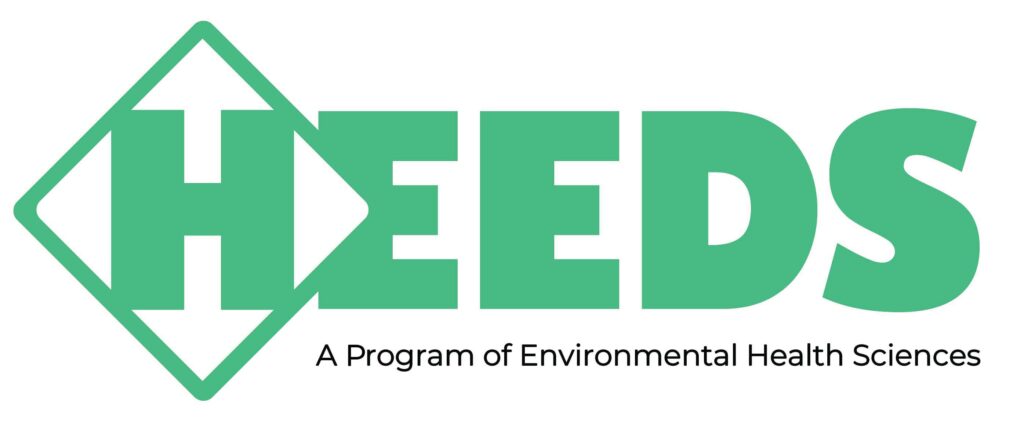
Healthy Environment and Endocrine Disruptor Strategies (HEEDS)
Vision
The HEEDS vision is a healthy global environment where all people are free of the harmful effects of EDCs.
Mission
The mission of HEEDS is to use multidisciplinary, collaborative and integrative science, communication, outreach and policy changes to achieve a world in which people, wildlife and ecosystems are free from the harmful effects of EDCs.
Values
We embrace our responsibility to create a healthy global environment free from the harmful effects of EDCs through:
- Proactive scientific and communication activities
- Innovative multidisciplinary science
- Inclusion of diverse expertise and approaches
- Accountability and transparency
- Honest and open communication
Overview
Endocrine disrupting chemicals (EDCs) are chemicals that interfere with the function of the endocrine system – the hormones that coordinate the health and function of all organs in the body. In some cases, they mimic the actions of hormones, in others they block the actions of hormones, and still others change how the body makes or breaks down natural hormones.
Because hormones are critical for normal body functions throughout life, chemicals that disrupt hormone actions, can lead to a variety of chronic diseases and health concerns in humans and wildlife. These conditions include certain types of cancers, infertility, obesity, diabetes, learning disabilities, and immune disorders, among others.
EDCs are chemicals that were designed for a specific purpose, for example, pesticides, plastics, flame retardants, solvents, etc. but due to structural similarities to natural hormones have the inadvertent side effect that they interfere with hormones. There are over 1000 chemicals that are known or suspected EDCs.
Scientific studies of EDCs have provided key data that can be used to improve human and environmental health. New studies are expected to continue these improvements. Yet the impact on health will only be as successful as scientists are at communicating these findings, and discussing their implications, with clinicians, the public, regulators and policy makers as well as scientists in other disciplines like chemists, material designers and chemical engineers.
Studying EDCs is particularly challenging because it requires knowledge from many disciplines including molecular physiology, chemistry, endocrinology, genetics and personalized medicine, evolution, population ecology, economics and sociology. The EDC field is also supported by environmental health scientists, mostly in academia, who study the effects of EDCs on human and wildlife health. They are funded mostly by government agencies like the US National Institutes of Health, the US Environmental Protection Agency and the European Commission.
Scientific societies, advocacy groups and non-governmental organizations (NGOs) have also worked tirelessly and diligently to communicate the importance of EDC exposures for human and wildlife health.
Because there is no endocrine disruption scientific society: University departments or degrees on endocrine disruption studies, we created HEEDS with the goal to integrate, coordinate and communicate scientific developments in the endocrine disruption/EDC field.
What Makes HEEDS Different?
EDCs present an existential threat to our present-day civilization. Thus, it is impossible to have a sustainable chemical enterprise without addressing the many challenges of EDCs.
HEEDS is a coalition of scientists for scientists. Our overall goal is to help provide the data and framework needed to facilitate change in the manufacturing, marketing and management of chemicals to avert the ongoing erosion in the welfare of life on earth.
HEEDS accomplishes this goal by focusing on the scientists working in the EDC field and on the scientific evidence evaluating the effect of endocrine disruption on human and wildlife health. HEEDS focuses on improving communication, coordination and collaboration among scientists working on EDCs. HEEDS also aims to educate policy makers, regulatory agencies, physicians, and the general public.
Collaboration/Coordination
The major coordination goals of HEEDS are: 1) to support and help coordinate the science that provides data on the role of EDCs in worsening chronic global health threats, 2) to support regulations that protect humans and the environment from exposure to EDCs, and 3) to improve testing for endocrine disruptor activity.
Scientifically, HEEDS is interested in all aspects of EDCs and their effects across the lifespan and generations. The goal is to be proactive in its activities to help move the EDC field forward. We focus on evidence collected from in vitro systems, animal models, and human studies. HEEDS works with scientists to help develop and interpret the scientific data, fill research gaps and better understand the impact of EDCs in disease etiology and susceptibility across the lifespan and generations.
HEEDS achieves its goals via a wide variety of activities, e.g. local EDC focused groups, working groups focused on chemicals and/or diseases caused by EDCs, an Annual EDC Strategies Brainstorming Workshop, promotion of EDC focused sessions at national and international scientific meetings, webinars, blogs, publication of peer-reviewed articles, and improved mentoring and grantsmanship skills of young scientists.
Communication
We also work to improve communication strategies. We are focused on developing messaging about EDCs to journalists, public audiences, medical professionals, policy makers and government agencies to communicate the best evidence demonstrating the impact of EDCs on human and wildlife health.
HEEDS works to assure that scientists working on all aspects of EDCs feel free to focus their research on topics of their choosing and to speak freely on the importance of EDC science without worry of intimidation or harassment.
HEEDS works with scientists; local, national and international governments; advocacy groups and NGOs; scientific societies; journalist; policy makers; and local EDC working groups. Major communication strategies aim to educate and provide current and timely resources on the hazards of exposures to EDCs. Our work also addresses how EDC exposures can be reduced and thereby improve health.
